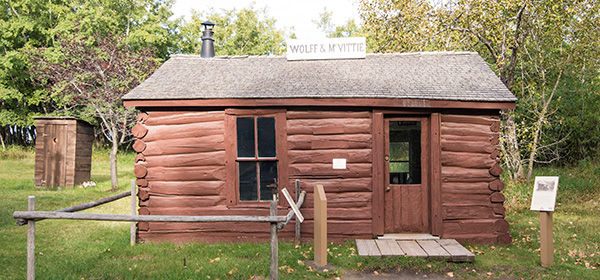
Sept. 26, 2013 | Cody Stuart
From Small Beginnings Come Big Things
When looking at those buildings that helped shape the city we call home, sometimes the significance lies in the building itself, and sometimes it lies in its inhabitants.In the case of the Wolffe & McVittie Cabin, an argument could be made for both. Despite it's modest appearance, it could be said that the Wolffe & McVittie Cabin is one of the most noteworthy structures in all of Calgary.
"The Wolffe & McVittie Cabin is significant because it represents one of the first permanent buildings erected in Calgary, and it was the home of Dominion Land Surveyor Archibald Westmacott McVittie who surveyed the new Calgary townsite in 1884," said Barb Munro, communications specialist at Heritage Park Historical Village, where the cabin now resides. Constructed using driftwood, logs, lumber scraps, and packing crates, McVittie built the cabin on the banks of the Elbow River following upon hearing the new Canadian Pacific Railway (CPR) station would be built nearby.
A far cry from the city of 1.15 million we know today, Calgary had just been incorporated as a town that year on Nov. 7, and was then home to just 506 residents. Tasked with surveying the new townsite, McVittie would have used a 66-foot, 100-link surveyor's chain to map out the 36-mile township into one-mile sections.
Between 1879 and 1889, Dominion Land Surveyors mapped a section of land 61 million acres in area, a section one-third the size of Alberta.
Along with Treaty 7 – the peace agreement between representatives of the Blackfoot Confederacy and the Canadian and British governments – and the appearance of the North-West Mounted Police in Alberta in 1874, the arrival of the CPR played an integral role in Calgary's formation.
Able to make or break the success of a town, speculators and merchants pitched tents on the Elbow River even before the line was completed in 1883. By linking Calgary to the more established metropolitan centres in Eastern Canada, it enabled the young towns cattle business and related manufacturing and processing operations to flourish.
Shortly after McVittie sold his home to George and Mary Jacques, who would add a floor and stove to the ramshackle cabin in 1890.
Having survived the great fire of 1886 which engulfed the main business section, town council's ordinance that all large downtown buildings must be constructed of sandstone would lend Calgary its nickname of "the Sandstone City" following its incorporation as a city in 1894.
In addition to being the city's largest employer, the railway greatly affected Calgary's physical development through its placement of spurs and rail facilities. By 1907, the CPR freight yards switched 700 cars daily, and employed 300 men. Evidence of the CPR's importance was visible everywhere, from the railway station and freight yards to the new CPR Hotel, named the Palliser. Many of Calgary's most sought after neighbourhoods, such as Mount Royal, owe their existence and prestige to the railway. Even the townsite of Calgary itself, originally on the Elbow River, was relocated to the railway's section, three-quarters of a mile west of the initial site.
Already having moved the home once to ninth Ave. S.E., the Jacques sold the near-half-century-old cabin to J.B. Cross in 1933. It would serve as a gift shop at the Calgary Zoo until 1965 when Cross donated the cabin to Heritage Park, where it stands today as a reminder of our city's modest roots, and those initial residents that helped shape the city.
"We can use many words to describe the early settlers of Western Canada; trailblazers, groundbreakers, pioneers; to sum up in one word, innovators," said Munro. "They built their meager homes ou8t of the only material available to them; they learned how to cultivate the land; they raised livestock, struck black gold and built cities from the ground up. Their achievements are what make Western Canada, and specifically Calgary one of the best places in the world to live today."
For more information on the Wolffe & McVittie Cabin and their many other historic buildings, visit www.heritagepark.ca or call 403-268-8500. Heritage Park is open on weekends from 10 am until 5 pm until Oct. 14.
Tagged: Calgary Heritage | Calgary Real Estate | Calgary Real Estate News | Heritage Park




